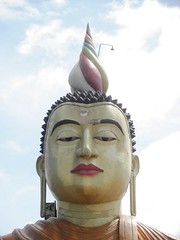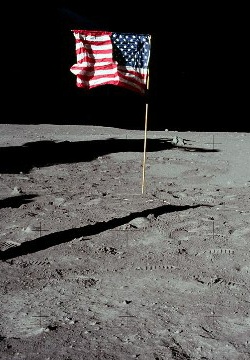Bhuj is an unloved place. Even its name stinks of sloppy neglect. "Bhuj". Why not call it "Flump" or "Blop" and get it over with? Bhuj is more or less forgotten by the rest of India owing to its great isolation. It is part of the region of Kutch, a dry, sparsely populated mound of dirt cut off from the rest of the world by the ocean and by the temperamental Rann of Kutch. During the summer monsoons the Rann is a treacherously flooded saltwater marsh interspersed with small dots of sand and brush. Kutch becomes an island for several months. For the rest of the year the Rann dries up and becomes a searing, lifeless expanse of white-hot salt. (Click on this Google Maps Link to see where adjacent satellite grid photos were taken at different times of the year near a seasonal "island" in the northern Rann). I am assured that it has a captivating beauty but circumstances have conspired that I should hardly see it. I caught a glimpse while leaving Kutch. The southern highway crosses the Little Rann at its narrowest point. This corridor - along the highway and near to industrial centers and ports - was not beautiful at all. High-voltage power lines and fuel pipes followed alongside on salt-encrusted stilts, and the mighty jaws of industry had crushed the natural habitat into a giant salt farm. As far as the eye could see there was salt - mounds and mounds of it, slumping at perfectly regular intervals next to barren quadrilateral units of salt-raked mud. Near the road, salt-farmers had built their homes on company land, carelessly piled dirt with tight clusters of appaling concrete boxes tilted perilously on the shifting heaps. Where nature had grown danger, man has tamed it and built despair.
Kutch (or Kachchh as the orthographical masochists seem to prefer) has lain behind this barrier for centuries, ever the wealthless spoil of third-rate conquerors who ventured across the wastes to claim that which the mighty hadn't bothered with. It shelters a culture quite unlike the rest of India, where only a handful of outpost-like frontier towns punctuate the fields of dust and distant villages where life seems trapped in a different age. In the far south is the port of Kandla, hanging onto India by the taut thread of the causeway over the Little Rann. The rest of Kutch is a land forgotten.
In Bhuj you can't help but see the tribal life of the villages all around you. While the men of the tribes tend to their sheep and camels in the desert, the women make crafts in the village and come to town to trade. There are the Jat women with their coil-like necklaces, old Rabari women with their embroidered black dresses, Ahirs with their noses pierced by a heavy ring supported by knotted locks of hair. There are the Patels, the traditionally settled people of the towns walking about in all white, and the grubby Sindhis, Hindu refugess from Pakistan who make their living in the modern industries. I even saw a number of Siddis, the African-descended laborers who with sad predictability comprise an extremely low caste in society.
Apart from the vibrancy of the ancient ways of life, Bhuj also echoes with loss. In Mt. Abu I saw a shrine where pilgrims worship the spot where Shiva's toe steadied an earthquake. They will build no such shrine in Bhuj.
In 2001 most of Bhuj, and indeed much of Kutch, was utterly demolished by a catastrophic tremor. The medieval heart of Bhuj collapsed in moments. The mud-walled villages had no chance. The slowly-restoring ruins of Bhuj's palaces are all that's left of the old town. The windnig medieval streets remain, turning through loops and zig-zags as they have for generations. But now the idiosyncratic alleyways of history have been shattered like a glass jar; the trapped air of the past has rushed out never to return, and the alley walls have been pieced together with the cold, textureless conformity of modernity like so much duct tape. The new Bhuj is bricks and painted concrete. Many in India would be overjoyed to have housing built to the high standard of reconstructed Bhuj, but the piles of ancient bricks lying broken in overgrown backlots on narrow lanes from an unmistakably earlier era tell of something lost. While the world has forgotten Kutch, Kutch now struggles against forgetting itself.
Determined to see what of this land's aura still shines out from beneath the rubble, I walked through the citadel gates, past the crumbling remains within, and inquired as to the status of the palaces. The curator, a humble scholar with a passion for the history and culture of Kutch, told me wearily "Regretably you have come when the palace is closed." I slumped and murmured "Oh, I see," then began to walk away sullenly, thinking that the arduous journey to Kutch may have been for nought.
"Please come back at 3 in the after-noon. Then Bhuj siesta time is over."
Palace open? Siesta? Museum curator makes the basket and gets the foul call. 3 points.
I returned promptly at 3 and began my tour of the palaces. The oldest, the Darbargadh, was a crumbled shell and looked unlikely to ever be fully restored. The second-oldest, the Aina Mahal, was open and fascinating. The first few rooms hinted that it would be one of my favorite kinds of Indian museum: the royal junk collection. As the maharajas still own most of their old palaces (or control them through charitable trusts) the contents and management thereof remain subject to their royal idiosyncracies, the result usually being that these palaces house mountains of crap that nobody without a gilded-tuft turban has cared about in 60 years. You find polo trophies, preposterous portraits, silver-plated butt-scratchers ("back-scratchers"), outrageously impractical firearms, stamp collections, ivory parcheesi sets, taxidermed animals, and above all: entire galleries of paintings and photos of the king with other dignitaries hunting soon-to-be-taxidermed animals. The Maharaos of Kutch - though lacking in the wealth of the Maharajas of Jaipur or the arrogance of the Maharanas of Mewar - did amass a wonderful junk collection.
Beyond the entrance halls you find the throne room, a lovely chamber of stone, tile, and painted wood where the Maharaos once sat on a platform amid a pool where delicate misting fountains cooled the air (and no doubt dampened the blouses of comely musicians). Kutch had one period of greater prosperity when it became a somewhat useful stop in the age of ship and sail. The palace is thus filled with a near-comical panoply of 18th-century European decor, featuring floors of blue tiles impeccably copied from the Dutch, mirrors imported from the Belgians, and cluttered hangings of portraiture that almost reek of month-old scones in their stale Britishness. There is also some lovely art of the native Kutchi style, which is actually a charming fusion of Chinese and European painting of the era executed on glass. Taking this fusion perhaps a step too far, the subjects of these paintings seem largely to be slant-eyed white peope in frocks with incongruously off-center probosci for noses.
Moving on to the Prag Mahal, I was prepared for boredom. The newest of the palaces, the Prag Mahal belongs to that tragic interlude in Indian architectural history when many large structures were built in the Victorian "Gothic" style with Indo-Islamic pretensions. I expected the over-spacious yet stuffy ambiance of an overblown but still second-rate English manor, as so many late Indian palaces tend to be. I found not tedium, but horror.
First of all, the most Victorian thing about the palace is not its pseudo-monastic collonades or even its superfluous belltower, but the bewildering number of pigeons residing (and shitting) within. The earthquake-splintered ceilings bow under the weight of shifting masses of the flying rats, and the commonplace random detonation of Indian fireworks sends Hitchcockian flocks of them careening along the balconies and tumbling through the hallways with little regard for earthbound objects and people in their path.
The Grand Hall is quite grand, adorned with small engravings of masculine Roman types enacting Biblical dramas and massive half-naked man-statues with tantalizingly loose man-cloths supporting the upper gallery with their oh-so-dreamy man-arms. The effect is, however, rather lessened by half of the eiling falling off and the the chandeliers hanging snapped and crooked. Besides the great hall only a few rooms are open, and these contain the royal taxidermy. The horror...pure horror.
Suffice to say, the royal taxidermy did not fare well in the earthquake. Nevertheless, it has unfathomably been put back on display despite being in a state of complete ruination. The animals are sewn back together wrong or not at all, halves of heads split asunder as though by an axe-blow, or worse. Some of the species can't be recognized. Others... oh God, the hippo... resemble the tumultuous proto-erotic nightmares of a Joseph Mengele, abominations Victor Frankenstein wouldn't stitch from the grave, the profucts of a frenzied schizoid trapped in a dungeon of needles and carcasses. My friends, I took a few photos, but be warned, some things can not be un-seen.
I returned to my hotel room and slept poorly. The mosquito bites I suffered from an uncloseable window seemed all too much like the pinpricks of a madman drunkenly sealing flaps of flesh after spilling a bag of sawdust in the dried-out cavity where my liver should be.
I was to go to some villages, a distant monastery, and go wandering to the edge of the Great Rann in the north, but when I stopped by the police station for the cursory permits required to visit the borderlands I was surprised to find my commonplace application rejected. Turns out the Chief Minister (governor) of Gujarat was visiting the area and demanded complete security, lest a foreigner enter the 250-kilometer radius of his whereabouts and make a dastardly suprise attack across an endless horizon of salt. This Chief Minister, a Mr. Narendra Modi, is a borderline fascist. I don't say this because he inconvenienced me (which he did), but because he is "suspected" or complicity in abetting modern-day progroms against Muslims. Mr. Modi joins my shitlist of Indian public figures in second place just beneath the Maharana of Mewar.
I left Kutch the next day, taking the salty highway I described above. Kutch may have been leveled by a terrible earthquake, but it is time for the land of Saurastra to feel a true calamity. Ghostface Buddha is coming.
Dec 10, 2009
Subscribe to:
Post Comments (Atom)









No comments:
Post a Comment
Commenting Rules:
1)No spam, viruses, porn etc.
2)DO NOT POST GF-B's REAL NAME
3)Remember this is a public website, don't provide sensitive info about yourself in the internet!